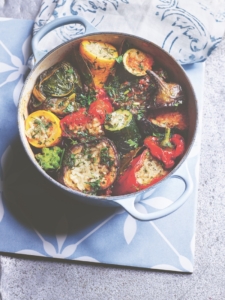
Egyptians love to stuff vegetables. There are meat and fish versions of the mahshi, but this one is completely plant based – it’s a feast for the eyes and the stomach. This wonderful selection of vegetables is roasted and then filled with a delicious tomato and rice mixture laden with spices, herbs and nuts. The Egyptians call this a ‘family’ of vegetables, the perfect collective noun I always think. I’ve used tomatoes, courgettes and aubergines, but you can also use blanched chard leaves or well-rinsed vine leaves from a jar to wrap around the rice mixture. A vegetable corer is an invaluable addition to your kitchen kit to aid the stuffing process. Any vegetables left over are equally delicious the next day served cold as part of a picnic or mezze.
Serves 4–6
2 small green courgettes, halved widthways
2 small yellow courgettes, halved widthways
2 small aubergines, halved widthways
olive oil
leaves from a bunch of chard
2 long red Romano peppers, halved widthways and deseeded
2 tablespoons tomato purée
1 litre vegetable stock (fresh or homemade is best)
50g baby plum or cherry tomatoes, halved
3 fresh bay leaves
For the rice mixture
olive oil
1 small onion, finely chopped
1 teaspoon ground allspice
½ teaspoon ground cardamom
200g short-grain risotto rice
150ml vegetable stock (fresh or homemade is best)
30g flaked almonds
4 spring onions, thinly sliced
1 chard stalk, finely chopped
½ bunch of coriander, leaves and stalks chopped
½ small bunch flat-leaf parsley, leaves and stalks chopped
a handful of chives, chopped
fronds from a handful of dill, chopped
sea salt and freshly ground black pepper
First make the rice mixture. Heat a good splash of olive oil in a saucepan over a medium heat. When it is hot, add the onion and fry for a few minutes until softened but without colour. Add the allspice and cardamom and stir for 2 minutes to cook out the raw flavours, then stir in the rice, ensuring it is fully coated with the spiced oil. Season with salt and pepper, pour in the vegetable stock and bring to the boil, then simmer the rice until the liquid is nearly evaporated. Remove the pan from the heat and stir in the almonds, spring onions, chard stalk and three-quarters of the fresh herbs. The rice is still uncooked at this stage. Set aside and leave to cool.
Using a vegetable corer, teaspoon or melon baller, hollow out the courgette and aubergine halves, leaving a 0.5cm edge of flesh – you will have a sturdy cavity to fill with the rice. Set aside.
Lightly fry the aubergines in olive oil over a medium heat to blister and cook their skins. Transfer to a plate lined with kitchen paper and leave to cool.
In the same pan, over a low heat, lightly sauté the chard leaves just until they start to wilt. Transfer them to a clean tea towel and spread the leaves out fully to cool.
Now stuff the peppers, aubergines and courgettes with the rice mixture – don’t overfill or pack tightly, as the rice will expand as it cooks. Lastly, divide the remaining rice mixture among the chard leaves and wrap into parcels that are fully sealed so none of the rice comes out. I use wooden cocktail sticks to keep them secure.
Heat a generous splash of olive oil in a large flameproof casserole or sauté pan with a tight-fitting lid over a medium-high heat. When it is hot, add the tomato purée and stir for a minute or so to cook out the rawness. Place the aubergines, peppers and courgettes in the casserole, stuffed side up so as not to lose any rice. The vegetables should fit snuggly so they support each other. Drizzle with olive oil, pour around the stock and add the chopped tomatoes and bay leaves and season with salt and pepper.
Bring the liquid to the boil, then lower the heat to a simmer and add the chard parcels. Cover the casserole, reduce the heat to low and simmer for 25–30 minutes. Remove the lid and continue simmering for a further 7 minutes until all the vegetable cases are tender.
Turn off the heat and leave the vegetables to rest for 10 minutes before transferring them to a serving platter. Spoon over some of the sauce and sprinkle with the remaining fresh herbs. Serve any leftover sauce on the side.
